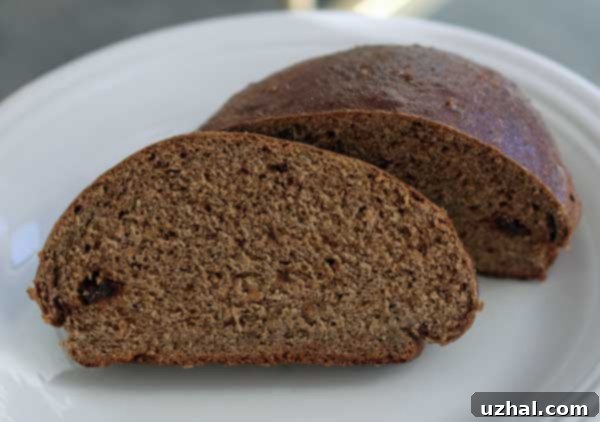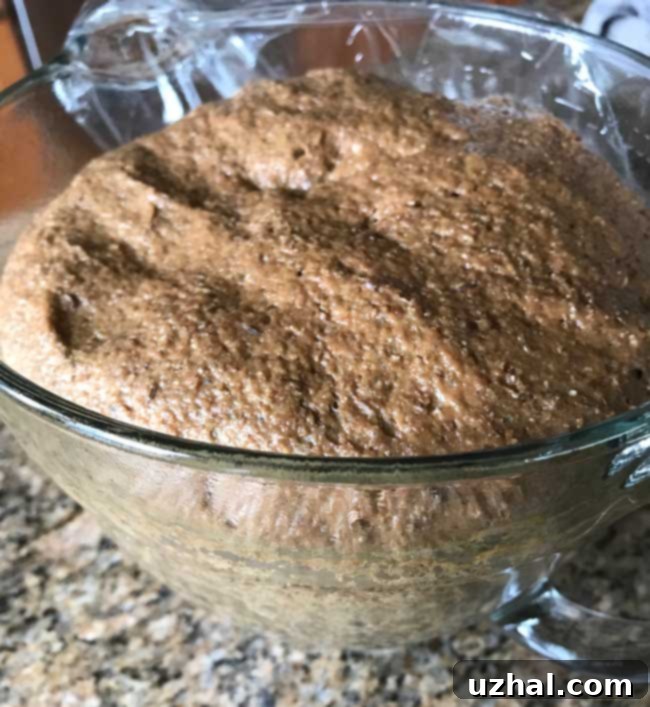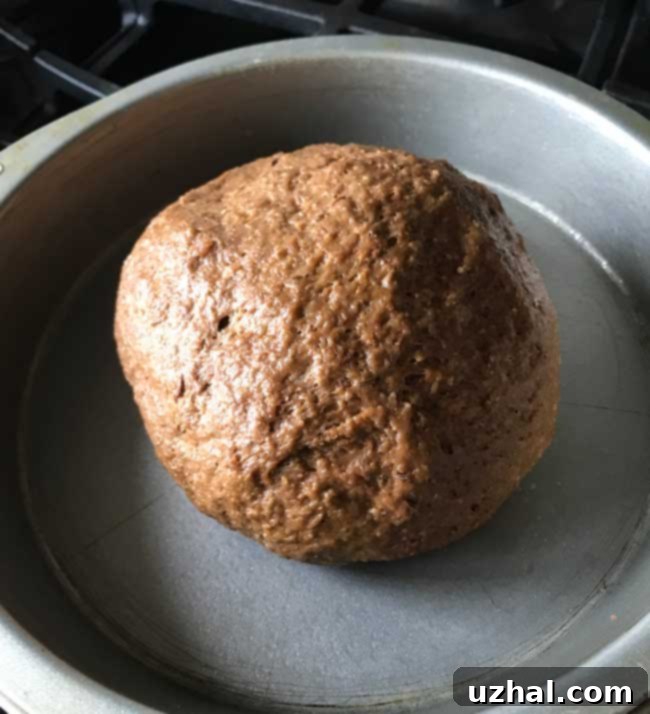Authentic Russian Black Bread: A Journey from Exchange Trip to Kitchen Staple
The aroma of freshly baked bread can evoke powerful memories, and for our family, this Russian Black Bread recipe is steeped in them. It all started years ago when my daughter embarked on an incredible two-week school exchange trip to Russia. She immersed herself in Russian culture, made lifelong friends, and, much to our delight, discovered a profound love for their traditional black bread. While her Russian counterparts were fascinated by the novelty of American fast food, particularly McDonald’s, my daughter, affectionately nicknamed Fuzz, found her culinary heart captured by the rich, dark, and wonderfully dense loaves that are a cornerstone of Russian cuisine. This trip was more than just an educational experience; it was a cultural exchange that left a lasting impact on all involved, highlighted by a shared love for food – albeit different types!

Unveiling the Authenticity: A Recipe with Heart and History
The quest to recreate that beloved bread led me to an unassuming little bread baking book, a hidden gem I unearthed at a local garage sale many years ago. Its pages held what appeared to be a truly authentic Russian Black Bread recipe, a perfect homage to my daughter’s newfound favorite. This particular version stands out, not for the inclusion of onion as some variations might, but for its unique blend of intriguing ingredients: a hint of unsweetened chocolate, the deep notes of instant coffee, and the aromatic warmth of ground fennel and caraway seeds. These are the elements that weave together to create its distinctive, complex flavor profile. The foundation of this bread lies in two essential flours: everyday all-purpose flour for structure and ease of handling, combined with dark rye flour, which imparts its signature earthy taste and hearty texture. A touch of molasses is carefully added, providing just enough sweetness to balance the savory notes, making it an ideal accompaniment for a wide array of meals, from robust stews to delicate cheeses. It’s a bread that tells a story with every bite, a true testament to its culinary heritage.

The Secret to its Sheen: A Surprising Cornstarch Glaze
Perhaps one of the most intriguing and delightful aspects of this Russian Black Bread is its distinctive cornstarch glaze. For me, brushing a loaf of bread with a cornstarch mixture was an entirely new technique, one that initially raised an eyebrow of curiosity. However, the results were nothing short of spectacular. This simple glaze, applied toward the end of the baking process, bestows upon the bread a beautiful, subtle sheen, transforming an already appealing loaf into a truly elegant one. The glossy finish not only adds to its visual appeal but also contributes to a slightly crisper crust, contrasting wonderfully with the dense, moist interior. It’s a small detail that makes a significant difference, elevating this homemade black bread from good to truly exceptional. This unexpected touch is just one more reason why this recipe has become a treasured staple in our kitchen.

A Beloved Family Favorite: Continued Baking Adventures and Tips
That initial school exchange trip sparked more than just a passing interest in Russian Black Bread for my daughter, Fuzz; it ignited a lifelong passion. She returned home with an even deeper appreciation for its unique flavor and texture, solidifying its place as her all-time favorite bread. This unwavering love has inspired me to bake this particular recipe numerous times over the years. With each successive batch, I’ve refined my technique, gathered more insights, and added practical notes to ensure consistent success. The process of making this bread is as rewarding as the final product. It begins with the simple magic of yeast, transforming humble ingredients into a rising marvel.
Observing the dough through its various stages is a baker’s delight. The first photo below captures the dough after its initial rise, plump and airy, a testament to the yeast’s activity and the careful balance of ingredients. This crucial proofing stage develops the flavors and creates the characteristic texture. After this majestic rise, the dough is gently “punched down,” releasing trapped gases and preparing it for its final shaping. The second photo illustrates the dough at this stage, after it has been deflated and skillfully shaped into a smooth, ready-to-bake ball. This careful handling ensures an even crumb and a beautifully formed loaf. These visual cues are invaluable for bakers, helping to demystify the process and build confidence with this rustic yet refined bread.

Creating homemade Russian Black Bread is a rewarding endeavor, yielding two generous loaves bursting with complex flavors. The interplay of dark rye flour, the subtle sweetness of molasses, the bitterness of chocolate, and the aromatic spices like caraway and fennel creates a bread that is truly distinctive. It’s a wholesome, satisfying bread that’s perfect for a hearty breakfast, a robust sandwich, or as an accompaniment to soups and stews. Each slice offers a taste of Russian culinary tradition, brought to life in your own kitchen. This recipe has not only brought a piece of Russia into our home but has also become a cherished family tradition, celebrated with every delicious, dark, and aromatic loaf.

This recipe makes two loaves of Russian Black Bread, perfect for sharing or enjoying throughout the week.
Recipe

Russian Black Bread
Anna
Pin Recipe
Ingredients
- 1 ¾ cup rye flour, Bob’s Dark Rye (228 grams)
- 1 ¾ cup all-purpose flour (228 grams)
- 1 tablespoon brown sugar (12 grams)
- 1 teaspoon salt
- 1 ½ cups Raisin Bran or 1 cup of All Bran
- About 1 tablespoon caraway seed crushed
- ½ teaspoon fennel seed crushed
- 1 teaspoon espresso powder
- 2 ¼ teaspoons 1 packet quick rising yeast
- 1 ¼ cups water
- 2 tablespoons cider vinegar
- 3 tablespoons dark molasses (60 grams)
- ½ oz unsweetened chocolate (14 grams)
- 3 tablespoons butter (42 grams)
Cornstarch Glaze
- ¼ cup water
- 1 teaspoon cornstarch dissolved in 1 tablespoon of cold water.
Instructions
-
Combine the rye and white flours. Set aside 1 ½ cups and put the remaining 2 cups of flour mixture in the bowl of a stand mixer. Add brown sugar, salt, cereal, caraway seed, fennel, espresso powder and yeast and stir well.
-
In a saucepan, combine water, vinegar, molasses, chocolate and butter and heat until chocolate melts, stirring often. Let the temperature cool down to 125 degrees F , then add the saucepan mixture to the mixture in the stand mixer. Stir well.
-
Gradually add remaining 1 ½ cups of flour, about ½ cup at a time, until you have a soft dough. If you weighed the flour, you will probably need all of it. If for some reason your dough is too sticky, you may need a little more. It should just barely pull away from the side of the bowl as it is being kneaded.
-
Put the mixing bowl on the stand, attach the dough hook, and let the machine knead for 10 minutes.
-
Cover bowl and let rise in a warm (100 degree F) place. When dough has doubled, punch it down and shape into two balls. Place each ball in a greased 8 inch round pan. Let rise until doubled (about 30 minutes).
-
Bake the loaves in a 350 degree oven for about 45 minutes. When the bread is almost done baking, begin making the glaze.
-
To make the glaze, bring ¼ cup water to a boil. Add the dissolved cornstarch/cold water mixture and boil until thickened. Brush this over the baked bread.
Notes
- Cooking Light White Russian Tiramisu
- Soda Bread Buns with Fennel Seeds and Cranberries
- Mexican Wedding Cakes
- Caraway and Rye Peanut Butter Cookies
- Caraway Cottage Cheese Bread
